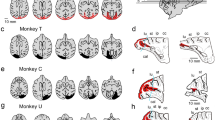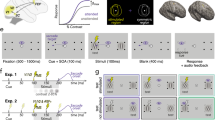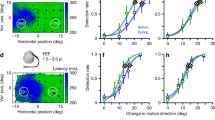Summary
Discussions of the cortical control of eye movement have generally attributed the generation of saccadic movements to the frontal eye fields (FEF) and the control of pursuit movements to posterior parietal or prestriate cortex. Monkeys were trained to perform a series of oculomotor tasks, including both saccade and pursuit paradigms. Surgical ablation of the frontal eye fields produced only minor disruption of saccade performance, but caused a dramatic deficit in the ability of monkeys to visually track a slowly moving target. This disorder has not previously been associated with FEF lesions. These results necessitate a major re-evaluation of the way in which the cerebral cortex participates in oculomotor control.
Similar content being viewed by others
References
Astruc J (1971) Corticofugal connections of area 8 (frontal eye field) in Macaca mulatta. Brain Res 33: 241–256
Bizzi E (1968) Discharge of frontal eye field neurons during saccadic and following eye movements in unanesthetized monkeys. Exp Brain Res 6: 69–80
Bizzi E, Schiller PH (1970) Single unit activity in the frontal eye fields of unanesthetized monkeys during eye and head movement. Exp Brain Res 10: 151–158
Blum B, Kulikowski JJ, Garden D, Harwood D (1982) Eye movements induced by electrical stimulation of the frontal eye fields of marmosets and squirrel monkeys. Brain Behav Evol 21: 34–41
Bruce CJ, Goldberg ME (1984) Physiology of the frontal eye fields. Trends Neurosci 7: 436–441
Bruce CJ, Goldberg ME (1985) Primate frontal eye fields. I. Single neurons discharging before saccades. J Neurophysiol 53: 603–635
Bruce CJ, Goldberg ME, Bushnell MC, Stanton GB (1985) Primate frontal eye fields. II. Physiological and anatomical correlates of electrically evoked eye movements. J Neurophysiol 54: 714–734
Colby CL, Miller EK (1986) Eye movement related responses of neurons in superior temporal polysensory area of macaque. Soc Neurosci Abstr 12: 1184
Daroff RD, Troost BT (1978) Supranuclear disorders of eye movements. In: Duane, TD (ed) Clinical ophthalmology, Vol 2. Harper and Row, Hagarstown MD, Chap 10
Deng S-Y, Segraves MA, Ungerleider LG, Mishkin M, Goldberg ME (1984) Unilateral frontal eye field lesions degrade saccadic performance in the rhesus monkey. Soc Neurosci Abstr 10: 59
Eckmiller R (1987) The neural control of pursuit eye movements. Physiol Rev 67: 797–857
Goldberg ME, Bushnell MC (1981) Behavioral enhancement of visual responses in monkey cerebral cortex. II. Modulation in frontal eye fields specifically related to saccades. J Neurophysiol 46: 773–787
Keating EG, Gooley SG, Kenney DV (1985) Impaired tracking and loss of predictive eye movements after removal of the frontal eye fields. Soc Neurosci Abstr 11: 472
Kennard MA, Ectors L (1938) Forced circling in monkeys following lesions of the frontal lobes. J Neurophysiol 1: 45–54
Künzle H, Akert K (1977) Efferent connections of cortical, area 8 (frontal eye field) in Macaca fascicularis. A reinvestigation using the autoradiographic technique. J Comp Neurol 173: 147–164
Kuypers HGJM, Lawrence DG (1967) Cortical projections to the red nucleus and the brain stem in the rhesus monkey. Brain Res 4: 151–188
Latto R, Cowey A (1971) Visual field defects after frontal eyefield lesions in monkeys. Brain Res 30: 1–24
Leichnetz GR (1981) The prefrontal cortico-oculomotor trajectories in the monkey. J Neurol Sci 49: 387–396
Leichnetz GR (1982) The medial accessory nucleus of Bechterew: a cell group within the anatomical limits of the rostral oculomotor complex receives a direct prefrontal projection in the monkey. J Comp Neurol 210: 147–151
Leichnetz GR, Spencer RF, Smith DJ (1984) Cortical projections to nuclei adjacent to the oculomotor complex in the medial dien-mesencephalic tegmentum in the monkey. J Comp Neurol 228: 359–387
Leichnetz GR, Spencer RF, Hardy SGP, Astruc J (1981) The prefrontal corticotectal projection in the monkey; an antero-grade horseradish peroxidase study. Neuroscience 6: 1023–1041
Lynch JC (1986) The interaction of prefrontal and parietooccipital cortex in the control of purposive eye movements in rhesus monkeys. Developments in oculomotor research. A satellite symposium of the XXX International Congress of Physiological Sciences. Proceedings, p 37
Lynch JC, Allison JC (1985) A quantitative study of visual pursuit deficits following lesions of the frontal eye fields in rhesus monkeys. Soc Neurosci Abstr 11: 473
Lynch JC, McLaren JW (1982) The contribution of parietooccipital association cortex to the control of slow eye movements. In: Lennerstrand G, Zee DS, Keller EL (eds) Functional basis of ocular motility disorders. Pergamon Press, Oxford, pp 501–510
Miller NR (1985) Walsh and Hoyt's clinical neuro-ophthalmology. Williams and Wilkins, Baltimore, pp 608–633
Mohler CW, Goldberg ME, Wurtz RH (1973) Visual receptive fields of frontal eye field neurons. Brain Res 61: 385–389
Newsome WT, Wurtz RH, Dürsteler MR, Mikami A (1985) Deficits in visual motion processing following ibotenic acid lesions of the middle temporal visual area of the macaque monkey. J Neurosci 5: 825–840
Robinson DA, Fuchs AF (1969) Eye movements evoked by stimulation of frontal eye fields. J. Neurophysiol 32: 637–648
Schiller PH, True SD, Conway JL (1980) Deficits in eye movements following frontal eye-field and superior colliculus ablations. J. Neurophysiol 44: 1175–1189
Schlag J, Schlag-Rey M (1985) Unit activity related to spontaneous saccades in frontal dorsomedial cortex of monkey. Exp Brain Res 58: 208–211
Troost BT, Abel LA (1982) Pursuit disorders. In: Lennerstrand G, Zee DS, Keller EL (eds) Functional basis of ocular motility disorders. Pergamon Press, Oxford, pp 511–515
Author information
Authors and Affiliations
Rights and permissions
About this article
Cite this article
Lynch, J.C. Frontal eye field lesions in monkeys disrupt visual pursuit. Exp Brain Res 68, 437–441 (1987). https://doi.org/10.1007/BF00248811
Received:
Accepted:
Issue Date:
DOI: https://doi.org/10.1007/BF00248811




